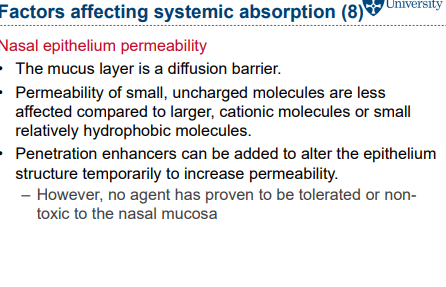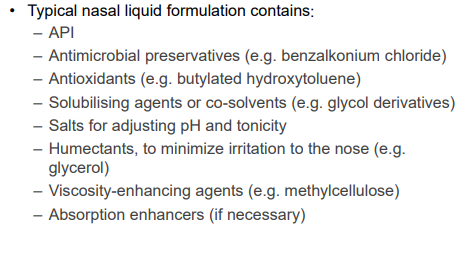Aural and Nasal part 1
1/42
There's no tags or description
Looks like no tags are added yet.
Name | Mastery | Learn | Test | Matching | Spaced |
|---|
No study sessions yet.
43 Terms
Advantages of the nasal route?
• Easy to administer.
• Non-invasive, painless.
• Avoids first-pass effect
• Low enzymatic activity
• Direct route to brain is possible
• Potential to elicit a rapid onset of action.
• Newer formulations potentially allow for peptide delivery.
• Could achieve better systemic bioavailability than the oral route:
what is the • Nasal cavity is divided in to two halves by?-
Nasal cavity is divided in to two halves by nasal septum
What is the nasal cavity covered by?
Covered with mucous membrane containing goblet cells secreting mucus
• Absorption occurs where in the nasal cavity?
across turbinates and septum.
Lipophilic drugs transported transcellularly by?
by concentrationdependent passive diffusion, by receptor mediated and vesicular transport mechanisms
• Polar drugs pass through epithelium via g..
a gaps between cells (tight junctions).
So limited to drug molecular size >1000 Da
Where is the olfactory mucosa located, and what is it in direct contact with?
: The olfactory mucosa is in direct contact with the brain and cerebrospinal fluid.
How can drugs reach the central nervous system (CNS) through the nose?
Drugs can potentially be absorbed across the olfactory mucosa and enter the CNS.
What advantage does the nose-brain pathway offer for drug delivery?
It potentially provides a rapid, direct route for drug delivery to the brain, bypassing the blood-brain barrier.
What are the primary functions of the nose?
he nose functions as a passageway for air movement into the respiratory tract and as an "air-conditioner" to humidify and warm the air.
What happens to large particles trapped in the nasal filter?
Large particles trapped in the nasal filter undergo rapid clearance.
How are particles in the mucus layer cleared?
Particles that impact the mucus layer on top of ciliated epithelial cells are moved towards the pharynx.
Why are particle deposition and clearance rates important?
They are of primary importance for both local and systemic drug delivery.
4o
What is the role of cilia on epithelial cells in mucociliary clearance?
Cilia transport mucus at a rate of 5 mm per minute toward the nasopharynx
What is the primary function of the mucociliary clearance system?
To remove foreign substances, including drugs, from the nasal cavity.
What is the normal mucociliary transit time in humans?
12–15 minutes.
What is the advantage of local drug delivery in treating nasal conditions?
permit rapid relief at a much lower doe vs oral
reduce systamtic side effects
where can • Intranasal delivery can be usefu?
emergency situations where rapid onset of action is required,
What type of solution is Sumatriptan nasal spray?
What is the bioavailability of Sumatriptan nasal spray?
a simple aqueous solution.
15.8%.
How is Sumatriptan primarily absorbed when using the nasal spray?
A minor part is absorbed intranasally, while the majority is absorbed via the gastrointestinal tract after the formulation is cleared and swallowed.
The small nasal absorption provides rapid relief.
factors affecting systematic absoption? solubility
• Drug must be in solution to be absorbed.
• Only 25-200μl of liquid can be administered intranasally
How can solubility issues be overcome in drug formulation?
formulating the drug as a suspension or powder in the micro-size range, but the drug must dissolve in the nasal cavity fluid before absorption.
overcoming solubility? (3)
The selection of a different salt form of an ionizable drug can improve its solubility.
different excipenets
Modifying the molecular form, including the use of a prodrug,
Factors affecting systemic absorption Lipophilicity/hydrophilicity
• Lipophilic drugs are rapidly absorbed from the nasal cavity by the transcellular route with bioavailability similar to that of IV.
Hydrophilic drugs are absorbed via the paracellular route (between cells) and this route provided a much smaller area for absorption.
How does the molecular size of a drug affect its absorption?
The rate and extent of absorption are inversely proportional to the molecular weight of the drug.
What is the absorption efficiency for drugs with molecular mass less than 1 kDa?
Drugs with molecular mass less than 1 kDa have relatively efficient absorption.
What particle size range adheres best to the nasal mucosa?
Particles in the size range of 10–50 microns adhere best to the nasal mucosa.
What is the pH of the nasal mucosa surface and mucus?
The nasal mucosa surface has a pH of 7.4, while the mucus has a pH of 5.5–6.5.
How does local pH change in certain nasal conditions?
The local pH becomes more alkaline in conditions like acute rhinitis and acute sinusitis.
What formulation pH minimizes local irritation?
A formulation pH close to the nasal mucosa's pH minimizes irritation, but a pH range of 3–10 is generally tolerated.
Which form of a drug is better absorbed in the nasal mucosa?
Unionized drug molecules with a higher LogP are better absorbed than the ionized form.
Factors affecting systemic absorption (6) Enzymatic activity
A broad range of enzymes are present in the nasal cavity
• Drugs may be metabolised in the lumen or as they pass across the epithelium.
Possible solution: to enzymatic actvity
– To include enzyme inhibitors in the formulation
– Use of prodrugs to reduce affinity of drug for the enzyme
. – Encapsulate the drug to limit enzyme access to it.
Factors affecting systemic absorption (8) Nasal epithelium permeability

How does increasing residence time in the turbinates affect drug absorption?
enhance drug absorption.
What is the role of mucoadhesive polymers in nasal drug delivery?
The mucoadhesive polymer can prlong in contact with the mucosa without being absorbed themselves.
Increase formulation viscosity increases residence time.
• Increase contact time not necessarily increase absorption.
Nasal liquid formulation

Nasal devices – dropper/squeezed plastic bottle
advanatge
disadvanatge
Cheap and simple systems for nasal delivery.
• Require considerable skill, dexterity to apply the liquid uniformly across the mucosa.
what are some problems with dropper or squeezer nasal devices ?
The liquid delivered too quickly causes formulation to drip from the nostril to throat, causing cough.
Volume administered is subject to patient technique. Only suitable for drug with large therapeutic window.
Nasal devices – nasal spray
Both solution and suspension can be formulated, in metered-dose pump or pre-filled syringe.
• Spray nozzle produces fine droplets (25-50μm)
advantages of nasal spray?
Deliver exact dose
Available as multi-dose in reservoir or unit-dose.
• Easier and faster to administer than drops, but requires priming
Nasal devices – nasal tube
For creams, gels and ointments for local effects.
• Messy to apply, applied with finger or cotton bud.
• Uncontrolled dose